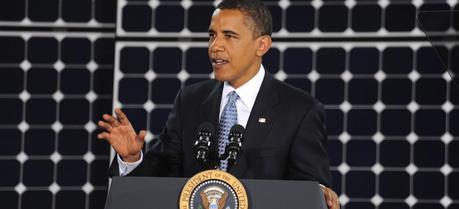 President Obama speaks about issues concerning world energy and the importance of solar power during a visit to Nellis Air Force Base. (Credit: U.S. Air Force Photo / Senior Airman Brian Ybarbo)
President Obama speaks about issues concerning world energy and the importance of solar power during a visit to Nellis Air Force Base. (Credit: U.S. Air Force Photo / Senior Airman Brian Ybarbo)The Energy Department announced that the U.S. solar industry is more than 60 percent of the way to achieving cost-competitive utility-scale solar photovoltaic (PV) electricity—only three years into the Department’s decade-long SunShot Initiative.
In 2011, the Energy Department launched its SunShot Initiative to make solar energy cost-competitive with traditional energy sources by the end of the decade. To achieve this goal, SunShot works to lower the price of solar electricity to $0.06 per kilowatt hour. Through partnerships with industry, universities, local communities and the Department’s national laboratories, the SunShot Initiative is working aggressively to drive innovation and lower the cost of solar energy—from more efficient, high-performing solar modules to streamlined permitting, installation and interconnection processes.
Today, the utility-scale PV industry is more than 60 percent of the way to achieving SunShot’s target of $0.06 per kilowatt-hour. In the United States, the average price for a utility-scale PV project has dropped from about $0.21 per kilowatt-hour in 2010 to $0.11 per kilowatt-hour at the end of 2013. According to the Energy Information Administration, the average U.S. electricity price is about $0.12 per kilowatt-hour.
Reductions in the cost of electricity are based on estimates of the levelized cost of electricity (LCOE). The LCOE is a measure of the national average of electricity cost based on certain assumptions regarding financing costs and generation availability projected over the life of a generating asset. The LCOE model provides a benchmark for measuring relative changes in electricity costs.
Within the past few years, utility-scale PV has risen from a relative newcomer to the solar market to the fastest growing sector of the industry. These projects feature large, centralized PV systems that feed power directly to the grid. While the operating history of utility-scale PV is brief, it is expected to dominate the overall PV market through 2016, helping create new jobs, support domestic manufacturing and boost economic growth as it expands.
One of the biggest benefits of our expanding solar industry is its impact on the U.S. job market. The Solar Foundation’s National Solar Jobs Census 2013 finds solar jobs increased nearly 20 percent since the fall of 2012—10 times the national average job growth rate. There are more than 140,000 solar workers in the United States, up from about 119,000 in 2012. Not only did the industry exceed growth expectations, the pace of hiring has quickened, producing new hires at a rate 50 percent higher than last year.

